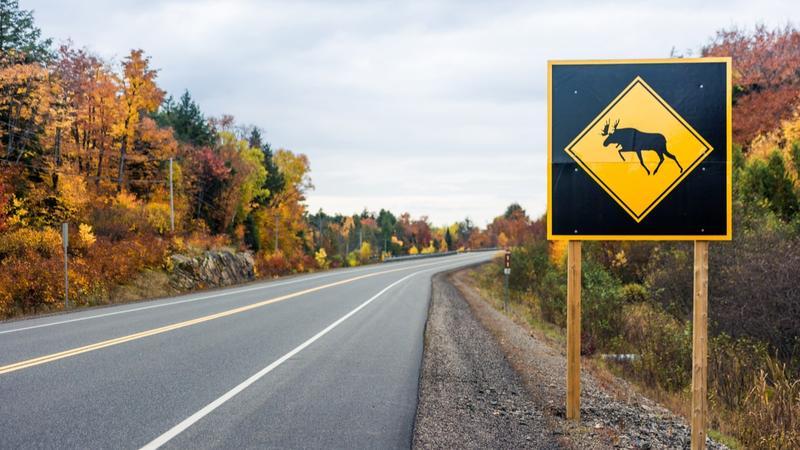Moose are impressive animals, but there’s one spot where you never want to see them: on or near a road that you’re travelling on. During fall, male moose are rutting, (competing for dominance to mate) and are actively on the move, especially at dawn and dusk.
Why are collisions with moose so dangerous?
Moose are big animals. At about two metres tall, they can weigh more than 1,300 pounds. Hitting an animal as large as a moose can wreak havoc on your vehicle. The most hazardous aspect of a collision with a moose is what happens after the animal is struck.
“When a vehicle hits a moose, the bumper, engine, and built-in crumple zones of the car that are intended to absorb the majority of an impact only hit the thin legs,” explains the Wildlife Roadsharing Resource Centre (WRRC), a project under the Traffic Injury Research Foundation. “The full weight of the moose’s upper body instead impacts the windshield and roof of the vehicle.”
This reality is what makes it especially important to watch out for moose while driving, particularly where they reside: rural areas with bodies of water (lakes, rivers, wetlands) nearby.
Tips to minimize the risk of hitting a moose on the road
The moose population in Canada is somewhere between 500,000 and 1 million, and the damage they can cause to your car is significant.
- If possible, try to avoid driving during high-risk times. Collisions are more likely to occur one hour before and after dusk and dawn; in October and November; and on two-lane highways.
- Watch for wildlife warning signs. These signs are usually placed in areas where there have been collisions or near misses reported.
- Scan your surroundings constantly. Watch for movement on the road ahead as well as to the sides. And if you’re driving with passengers, ask them to watch for animals, too.
- Do not speed. Every second of your reaction time counts if a moose or any other animal appears suddenly on the road.
- Use your high beams as much as possible. The more you can see, the better. But remember to use your high beams responsibly so that you’re not blinding oncoming traffic or those ahead of you.
What to do if you see a moose while driving
If you see a moose while driving:
- Don’t honk your horn. Resist the urge to flash your lights or honk to scare the moose away. According to the WRCC, moose tend to be aggressive, and this could provoke them to charge toward your vehicle.
- Slow down. Wildlife is unpredictable. Even if the moose appears to be a safe distance away, put your hazards on and slow down until you’ve safely passed them.
- Keep an eye out for more. Animals tend to travel in groups. Often when there’s one, there’s more.
If a collision with a moose is unavoidable, take your foot off the gas, grip the steering wheel firmly, and aim for the flanks (rear) of the moose to minimize the risk of the moose sliding across the hood of your car.
Will your car insurance cover the damage from a moose?
If your auto insurance policy includes both collision and comprehensive coverage, then you’ll likely be covered for the resulting damages. Which coverage applies, however, may vary depending on the circumstances of the collision.
Did the moose suddenly appear on the road? If so, then typically your comprehensive coverage would apply as there was little you could do to avoid it. Was the animal dead on the road from a previous collision? If so, then your collision coverage would probably apply as there’s an expectation that you should have seen it in enough time to make a reasonable — and safe — effort to avoid the collision.
“Cases like this are a great example of why insurance is complicated, and why consumers should always research their policies,” says Anne Marie Thomas, the director of consumer and industry relations at the Insurance Bureau of Canada. “By asking the right questions, consumers can make sure the policy is the right one for them.”
